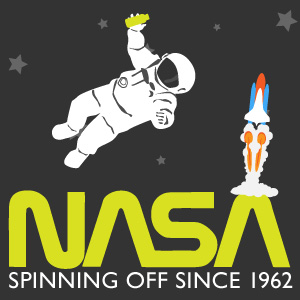September 16, 2014 – One of my readers shared the following infographic called NASA Spinning Off Since 1962. It highlights the inventions, discoveries and economic return on investment resulting from NASA. For every dollar invested by the government the American economy and other countries economies have seen $7 to $14 in new revenue, all from spinoffs and licensing arrangements. That amounts to in $17.6 billion current NASA dollars spent to an economic boost worth as much as $246.4 billion annually.
From the Black & Decker cordless vacuum, the Dustbuster, to ear thermometers and memory foam, we clean, check our temperature and get a good night sleep, here on Earth, on NASA-licensed spinoff technologies.
The winglet found on the wingtips of commercial aircraft today, an invention to reduce drag and improve fuel efficiency, came from NASA. Orthodontists use a translucent material called TPA for invisible braces – invented at NASA for an entirely different purpose. Farmers are using field sensors that tell them when their crops need watering – invented at NASA.
The list goes on and on.
Of course the downside to this argument is would the money spent elsewhere have yielded an equal if not greater return? Those who question NASA’s value point to the commercial spinoffs coming from research and technology investments through DARPA, the Defense Advanced Research Projects Agency.
DARPA’s annual budget today amounts to $2.8 billion USD, one-sixth NASA spending. DARPA inventions include a long list of pretty impressive commercial inventions and spinoffs. Here are the top 4 in my book – the Internet, GPS, 3D mapping, and virtual personal assistants like Siri in the Apple iPhone.
Of course DARPA technology didn’t deliver the first human to step on the Moon, and the International Space Station. And DARPA didn’t create the amazing technology that includes robotic rovers and spacecraft which send us pictures of Saturn’s astounding rings and moons, and desolate Martian landscapes. The investment in NASA may cost more but in my book it’s worth it.











